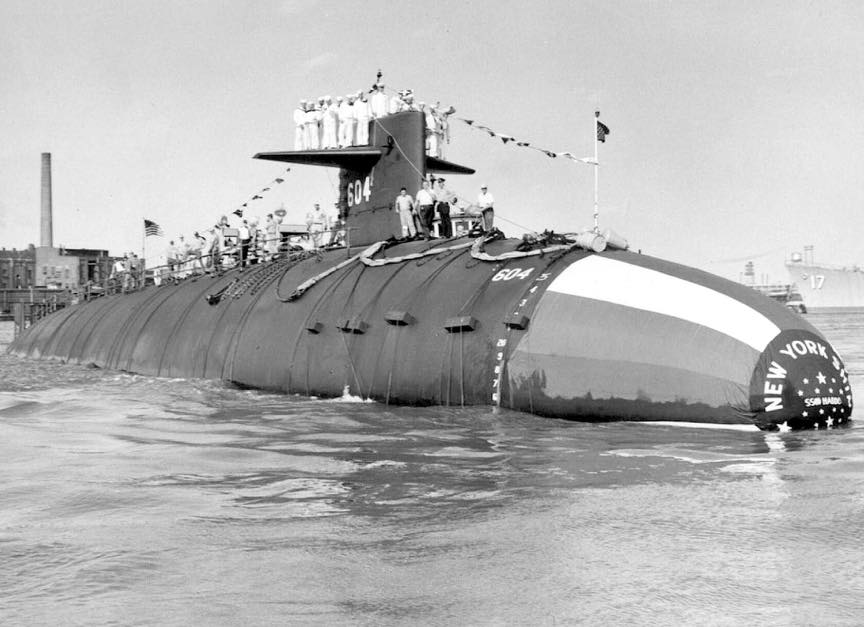Haddo II SSN-604

Haddo II
(SSN 604: dp. 3,700 (surf.), 4,300 (subm.); 1. 27S'6", b.
31'8", s. 20 k., cpl. 100; a. 4 91" tt., cl. Thresher)
The second Had do was launched by New York Shipbuilding Corp., Camden, N.J., 18 August 1962, sponsored by Mrs. Henry M. Jackson, wife of the Senator from Washington commissioned 16 December 1964, Comer. John G. Williams ;n command
After shakedown out of Ne~ London, Conn., in January 1966, Had do arrived at her home port, Charleston, S.C., 8 February and joined Sub Ron 4. She operated off the Atlantic coast and in the Caribbean until departing Charleston 7 July for the Mediterranean. She participated in number exercises with ships of the 6th Fleet and NATO countries before returning home 7 November. Had do has continued this pattern of service, alternating operations out of home port in the Atlantic with 6th Fleet deployments, through 1967.
Haddo received an eighteen-month "subsafe" overhaul at Charleston Naval Shipyard from August 1969 to April 1970. Following overhaul, Haddo's home port changed to New London, Connecticut, where she became a member of Submarine Squadron TEN. Haddo operated out of New London from 1971 to 1973. In the spring of 1972, Haddo completed the first six-month Mediterranean deployment for an SSN. In the fall of 1972, she again deployed to the Med, returning just prior to Christmas.
From August 1973 until December 1975, Haddo underwent an extensive refueling overhaul at Ingalls Shipyard in Pascagoula, Mississippi. In February 1976, Haddo's homeport shifted to San Diego, California and joined the Pacific Fleet as a member of Submarine Squadron THREE. The transit required Haddo to pass through the Panama Canal.
In the spring of 1977, Haddo departed for the Western Pacific, returning in the fall after an arduous six-month deployment. During the first three months of 1978, Haddo accomplished an intensive Selected Restricted Availability at Puget Sound Naval Shipyard in Bremerton, Washington. In December 1978, Haddo again deployed to the Western Pacific, visited New Zealand and returned in 1979.
Haddo arrived in Mare Island Naval Shipyard for another intensive Selected Restricted Availability in February 1980. In August of the same year she deployed to the Indian Ocean, visited HMAS Stirling in Western Australia from 16–22 December 1980, and returned to San Diego in February 1981.
In July 1981, Haddo deployed to the Western Pacific, visited Japan and returned to San Diego in late October 1981. Haddo arrived at Mare Island Naval Shipyard in April 1982 and underwent an extensive modernization and overhaul in January 1984, returning to San Diego.
From February to August 1985, Haddo again deployed to the Western Pacific visiting Japan and Hong Kong. As a result of her successful deployment, and superb operational reliability, Haddo was again awarded the Battle Efficiency "E" for Excellence for 1985. Haddo underwent an intensive Selective Restricted Availability in October 1985 in San Diego. Haddo then deployed to the Western Pacific from August 1986 to February 1987, again visiting Japan and Hong Kong. She completed several months of successful local operations before undergoing her last Selected Restricted Availability in San Diego from January to March 1988.
Haddo conducted a two-month ASW operation in June and July 1988. From February 1989 until February 1990, Haddo was deployed from San Diego over 300 days, conducting intensive operations in support of the National Defense, including a six-month deployment to the Western Pacific visiting Korea, Japan, Hong Kong and the Philippines. During her last of six WESTPACs, she also completed the longest continuously submerged period in her 25-year history. In the fall-winter of 1989 and 1990, Haddo participated in the largest Pacific Fleet naval exercise since 1945, PACEX-89, and conducted a two-month ASW operation in the northern Pacific. Haddo was decommissioned and stricken from the Naval Vessel Register on 12 June 1991. Ex-Haddo entered the Nuclear Powered Ship and Submarine Recycling Program in Bremerton, Washington, and on 20 June 1992 ceased to exist.
